In this lesson, we cover how to play Major 6 chords on guitar, which are more commonly used in jazz and can be used to add color to your chords.
We’ll first go over the music theory to understand Major 6 chords and then show you examples of how to play them throughout the fretboard starting on different strings. Let’s get started!
Major 6 chord theory
Major 6 chords are an extension of the Major triad and include the chord tones 1, 3, 5, and 6. The added 6th note adds a unique color to the chord. For example, a C Major 6 chord has the notes C, E, G, and A.
You can notate Major 6 chords with a 6 next to the root note. For example, C Major 6 can also be written as C 6 or C Maj 6.
As side note, Major 6 chords can be used interchangeably with Major 7 chords.
Major 6 chord formula
The formula for a Major 6 chord between each chord tone is 2 whole steps, then 1.5 whole steps, then a whole step. See the formula in the image below.
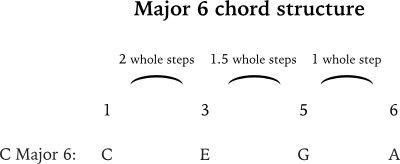
Major 6 chord chart examples
Here is a chart of the notes included in Major 6 chords starting on every root note.
| Major 6 chord | 1 | 3 | 5 | 6 |
|---|---|---|---|---|
| C Major 6 | C | E | G | A |
| D Major 6 | D | F# | A | B |
| E Major 6 | E | G# | B | C# |
| F Major 6 | F | A | C | D |
| G major 6 | G | B | D | E |
| A Major 6 | A | C# | E | F# |
| B Major 6 | B | D# | F# | G# |
| Db Major 6 | Db | F | Ab | Bb |
| Eb Major 6 | Eb | G | Bb | C |
| Gb Major 6 | Gb | Bb | Db | Eb |
| Ab Major 6 | Ab | C | Eb | F |
| Bb Major 6 | Bb | D | F | G |
How to read the chord charts
For the charts below:
- The top horizontal line of the chord chart represents the high E string and the bottom horizontal line represents the low E string.
- The vertical lines separate each fret.
- The numbers in the blue dots tell you which fingers to use on the fretting hand.
- The letters on the right of the charts tell you what notes you are playing on each string.
- Circles on the left represent open strings.
- Red X means to avoid that string.
You can check this link for more on how to read guitar notation symbols.
Common Major 6 chords
Here are some more common and practical Major 6 chord shapes that you can start applying to your playing. Afterwards, we’ll look at more chord shapes and inversions using the drop 2 chord system.
The following chord shapes are movable, meaning that you can use them to start on any root note. The numbers to the right of some strings refer to the chord tones related to the root note.
Shape 1: Major 6 chord – 6th string
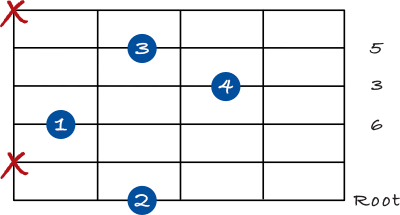
Shape 2: Major 6 chord – 6th string variation
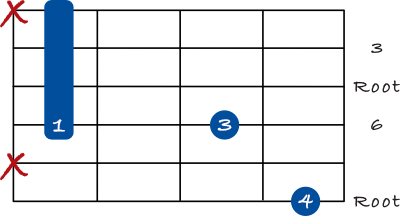
Shape 3: Major 6 chord on the 5th string

Major 6 chords on the 6th string
These following Major 6 chords are drop 2 chords because the second highest note gets dropped by an octave.
Root position
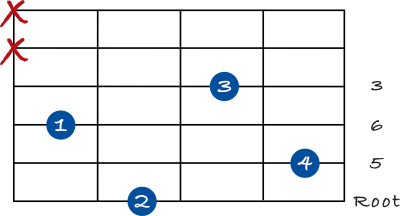
1st inversion
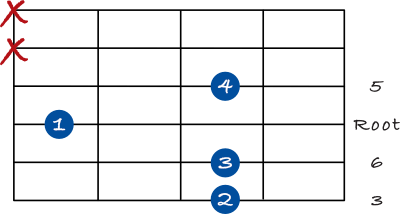
2nd inversion
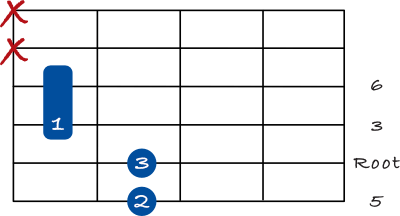
3rd inversion
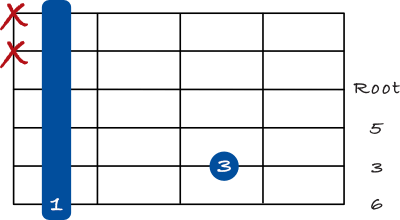
Major 6 chords on the 5th string
The following Major 6 chords are the same as the four previous ones except starting on the 5th string.
Root position
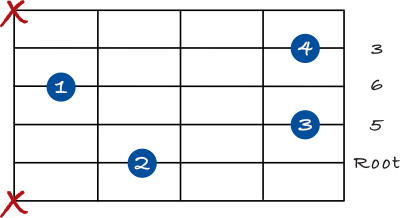
1st inversion

2nd inversion
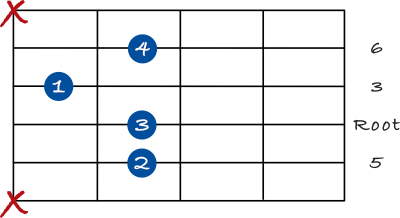
3rd inversion
The note on the 1st string here fits with the chord so we can add it as well.
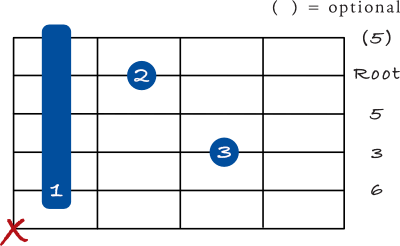
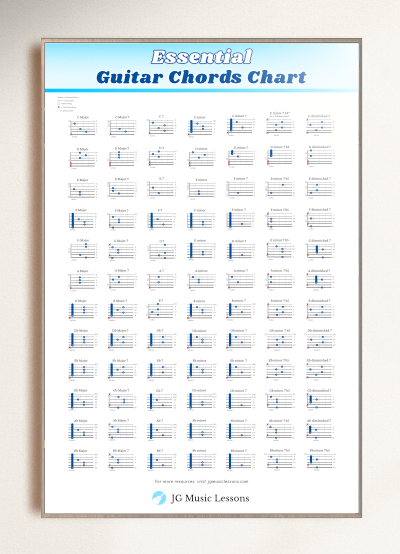
Major 6 chords on the 4th string
And here are the same drop 2 chord shapes starting on the 4th string.
Root position
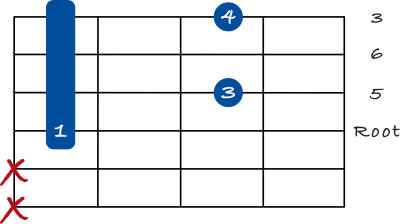
1st inversion
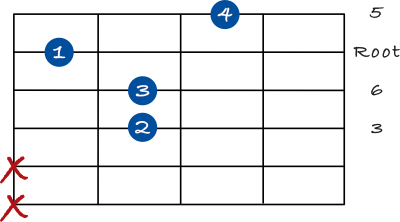
2nd inversion
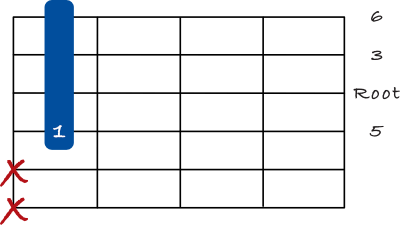
3rd inversion
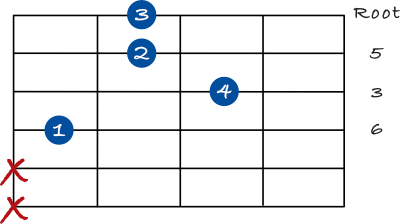
Bonus: Major 6 chords with extensions
The following shapes are Major 6 chords with added chord extensions. Also, note that the 6th degree is referred to as 13 whenever a 7th degree is included or implied in a chord. To learn more about chord extensions, see this lesson on how to play jazz guitar chords.
Major 6/9 on the 6th string
The symbol 6/9 is used to add the 6th and 9th to a chord. This can also be written as a Major 6 (9). If we include the Major 7 note, we can call this chord Major 7 (9, 13).
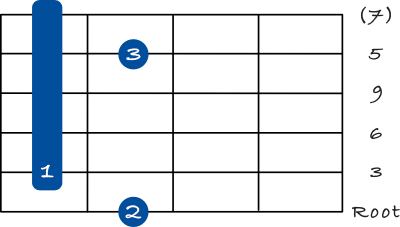
Major 6/9 on the 5th string
If we include the Major 7 note, we can call this chord Major 7 (9, 13).
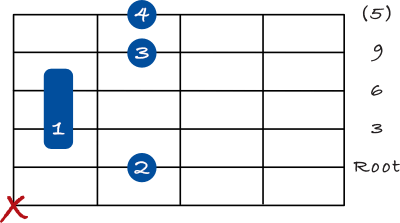
Major 7 (13) on the 6th string
If we include the 9th, we can also call this chord Major 7 (9, 13).
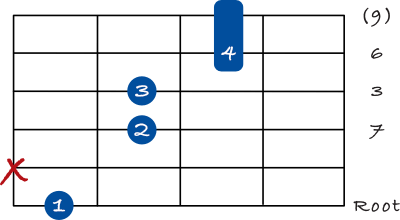
Major 7 (13) on the 5th string
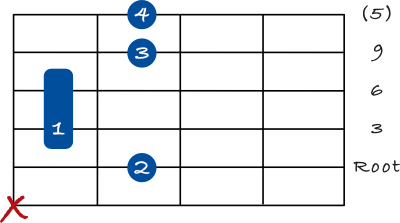
Wrapping up
In this lesson, we covered what Major 6 chords are, how to play them on the 6th, 5th, and 4th string, as well as some shapes with added chord extensions.
You can use these chords anywhere you would use Major 7 chords. Experiment with the sound of Major 6 chords to see how you can apply them in progressions and bring out different colors in your playing.
You can check out this other lesson to learn how to play minor 6 chords on guitar.
📘 Get the free guitar practice guide here!
All the best,
JG
Start Playing Better, Faster
with Pro Membership! ✨
Get the guidance, tools, and support that keep your progress on track:
🏁 Always know what to practice next. Access the full Guitar Learning Roadmap with lessons in sequence.
🎼 Play songs with confidence. Step-by-step lessons of popular, classical pieces and other styles.
📙 Save time and frustration. Clear PDFs and ebooks that save time so you can focus on playing.
🎟️ Get rewarded for consistency. 2 free downloads every month (a $240+ yearly value).
🎁 Keep costs low while you grow. 50% off all charts, tracks, and posters — up to 75% off bundles.
🚫 Stay focused. Ad-free environment keeps you in the zone.
💬 Get help when you need it. Direct member support to keep you on track.

